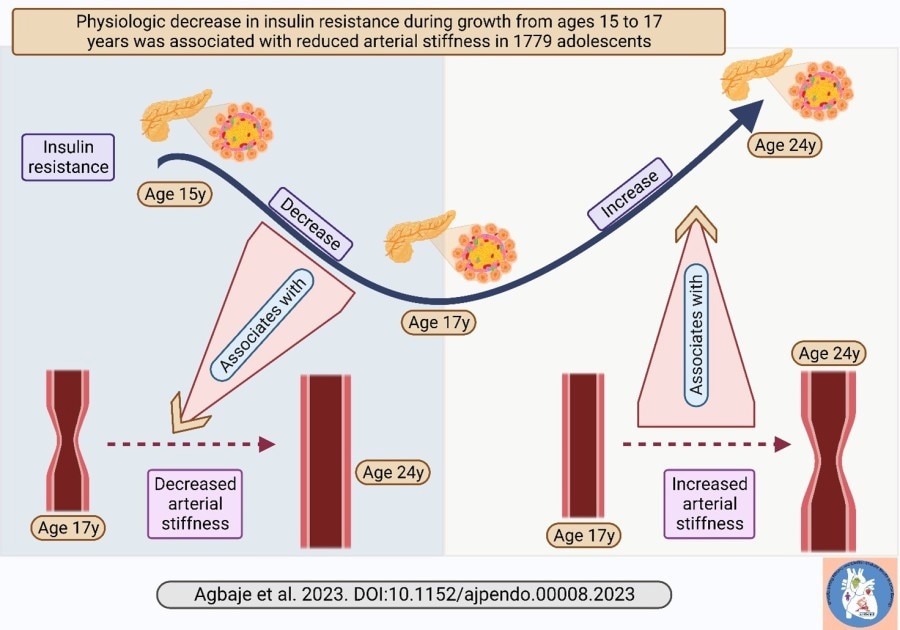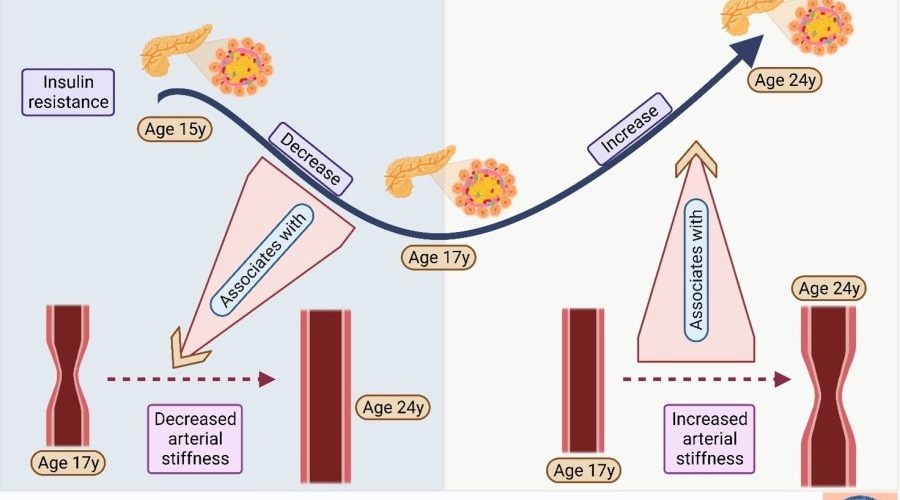Natural decline in insulin resistance during mid-adolescence may stop, reverse arterial stiffness progression
Significant physiologic decrease in insulin resistance during mid-adolescence may stop and reverse arterial stiffness progression, a paper published in the American Journal of Physiology-Endocrinology and Metabolism concludes. The study was conducted in collaboration between Baylor College of Medicine in the United States, Texas Children’s Hospital Heart Center in the United States, the University of Abuja in Nigeria, Guista Health Foundation in Nigeria, the University of Bristol in the UK, and the University of Eastern Finland.

Arterial stiffness is a novel cause of elevated blood pressure, hypertension, insulin resistance, obesity, and elevated heart rate in youth. Recently, low-grade inflammation was identified as a potential cause of arterial stiffness. Clinical trials targeted toward reducing arterial stiffness are underway but definitive treatment for arterial stiffness among youth and adults remains uncertain.
The current study was conducted among 1,779 adolescents who were 15 years old and followed up for 9 years until young adulthood at age 24 years. The results revealed that during growth from age 15 years to 17 years of age, fasting glucose, insulin, and insulin resistance significantly decreased. However, during growth from 17 years to 24 years, fasting glucose, insulin, and insulin resistance significantly increased even beyond the baseline values recorded at 15 years of age. The researchers observed that the reason for the significant decline in metabolic values from age 15 to 17 years could not be explained by the over twenty risk factors considered such as physical activity, early attainment of puberty, weight reduction, smoking status, and socioeconomic status. To the researchers' surprise, it was discovered for the first time that this unexplainable decline in insulin resistance from age 15 to 17 years may protect against worsening arterial stiffness. The researchers also noted that the arterial stiffness-protective effect of insulin resistance reduction may be sustained for additional years despite a slight increase in insulin resistance after age 17 years.
This unexpected and novel finding reveals that nature has forged a pathway for vascular health for humans, if sustained. Without any physical activity or dietary intervention whatsoever among thousands of adolescents, insulin resistance naturally dropped. This may suggest that expensive and time-consuming interventions targeted at lowering insulin resistance in healthy children may be unnecessary because almost everyone’s insulin resistance level will naturally decline after mid-adolescence to values typically seen in 10-year-olds. What is now crucial is the importance of sustaining the level of insulin resistance, glucose, and insulin at the value recorded at age 17 years due to its vascular protective ability. Replacing saturated fat with unsaturated fat in children’s diets, reducing salt intake, and increasing wholegrain products, fruit, and vegetable consumption are established dietary habits that can maintain lower levels of insulin resistance and increase insulin sensitivity in youth. The role of physical activity in promoting insulin sensitivity and decreasing insulin resistance in adolescence and young adulthood is currently being researched with results expected soon,”
Andrew Agbaje, A physician and Clinical Epidemiologist, The University of Eastern Finland.
Drug Discovery eBook

“We have recently shown that the reversal of dyslipidemia-related atherosclerosis may be successful if intervention is initiated at around age 17 years and that higher inflammation at age 17 years may cause arterial stiffness by young adulthood. It now appears that the gateway to healthy adulthood is late adolescence, and hence pediatricians, researchers, health policymakers, and caregivers need to pay special attention to this golden age or window of opportunity,” Agbaje says.
Dr Agbaje’s research group (urFIT-child) is supported by research grants from Jenny and Antti Wihuri Foundation, the Finnish Cultural Foundation Central Fund, the Finnish Cultural Foundation North Savo Regional Fund, the Orion Research Foundation sr, the Aarne Koskelo Foundation, the Antti and Tyyne Soininen Foundation, the Paulo Foundation, the Yrjö Jahnsson Foundation, the Paavo Nurmi Foundation, the Finnish Foundation for Cardiovascular Research and the Foundation for Pediatric Research.
University of Eastern Finland
Agbaje, A.O., et al. (2023) Cumulative insulin resistance and hyperglycaemia with arterial stiffness and carotid IMT progression in 1779 adolescents: A 9-Year Longitudinal Cohort Study. American Journal of Physiology-Endocrinology and Metabolism. doi.org/10.1152/ajpendo.00008.2023.
Posted in: Medical Science News | Medical Condition News
Tags: Adolescents, Arterial Stiffness, Atherosclerosis, Blood, Blood Pressure, Children, Dyslipidemia, Endocrinology, Fasting, Fruit, Glucose, Heart, Heart Rate, Hospital, Inflammation, Insulin, Insulin Resistance, Medicine, Metabolism, Obesity, Physical Activity, Physiology, Puberty, Research, Smoking, Vascular
Source: Read Full Article
